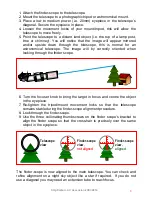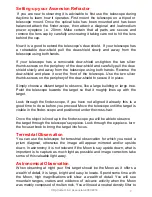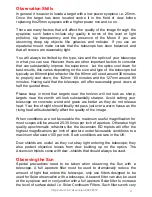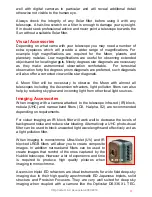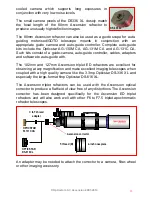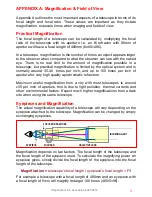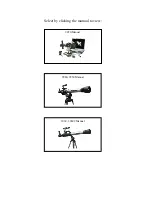
© Opticstar Ltd / Ascension 2007-2014
11
Observation Skills
In general it is easier to locate a target with a low power eyepiece i.e. 25mm.
Once the target has been located centre it in the field of view before
replacing the 25mm eyepiece with a higher power one and so on.
There are many factors that will affect the quality of the image through the
eyepiece; such factors include sky quality in terms of the level or light
pollution, sky transparency and the presence of the Moon if you are
observing deep sky objects like galaxies and nebulae. If you use an
equatorial mount make certain that the telescope has been balanced and
that all screws are reasonably tight.
You will always be limited by the type, size and the optics of your telescope
in what you can see. However there are other important factors to consider
that can substantially improve the experience. Let the optics cool down for
best results, this varies depending on the size and type of the telescope but
typically an 80mm triplet refractor like the 80mm will need around 30 minutes
to properly cool down, the 102mm 60 minutes and the 127mm around 90
minutes. Having said that the telescope will offer reasonably good views at
half the quoted times.
Please keep in mind that targets near the horizon will not look as sharp,
targets near the zenith will look substantially sharper. Avoid setting your
telescope on concrete; wood and grass are better as they do not release
heat. Your line of sight should ideally not pass just over a warm house as the
rising heat will substantially affect the quality of the image.
When conditions are not favourable the maximum useful magnification for
most scopes will be around 25-35 times per inch of aperture. Otherwise high
quality apochromatic refractors like the Ascension ED triplets will offer the
highest magnifications per inch of aperture under favourable conditions to a
maximum of around x100 per inch. Such conditions are rare in the UK.
Dew shields are useful as they cut stray light entering the telescope; they
also protect objective lenses from dew building up on the optics. The
Ascension triplets come with dew
–shields that should always be used.
Observing the Sun
Special precautions need to be taken when observing the Sun with a
telescope. A full aperture filter must be used to dramatically reduce the
amount of light that enters the telescope, only use filters designed to be
used for Solar observation with a telescope. A second filter can also be used
at the eyepiece end in conjunction with a full aperture Solar filter to increase
the level of surface detail i.e. Solar Continuum Filters. Such filters work very









